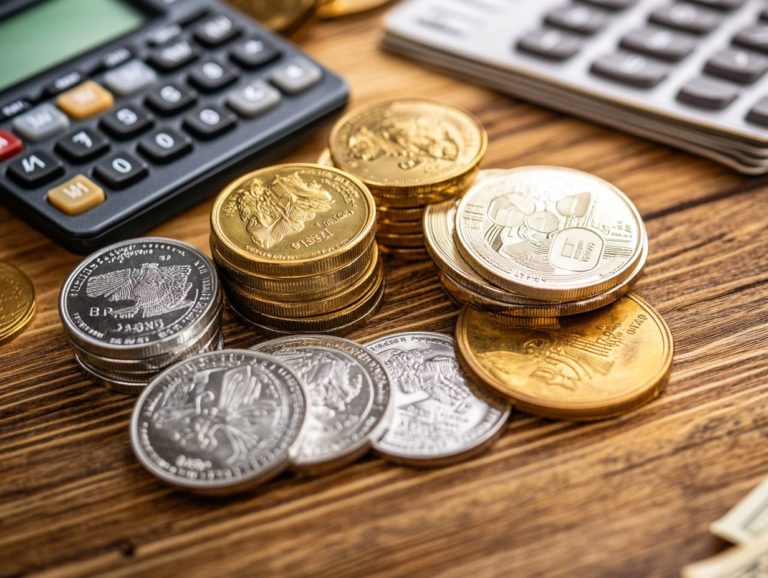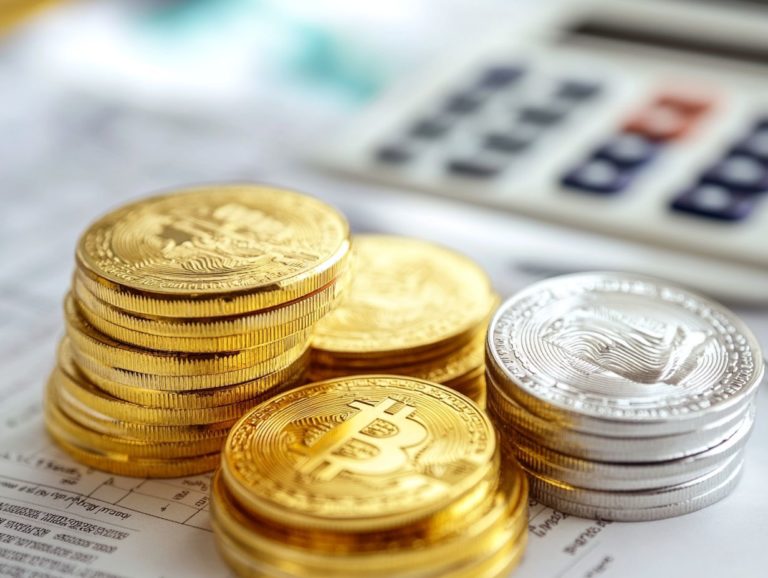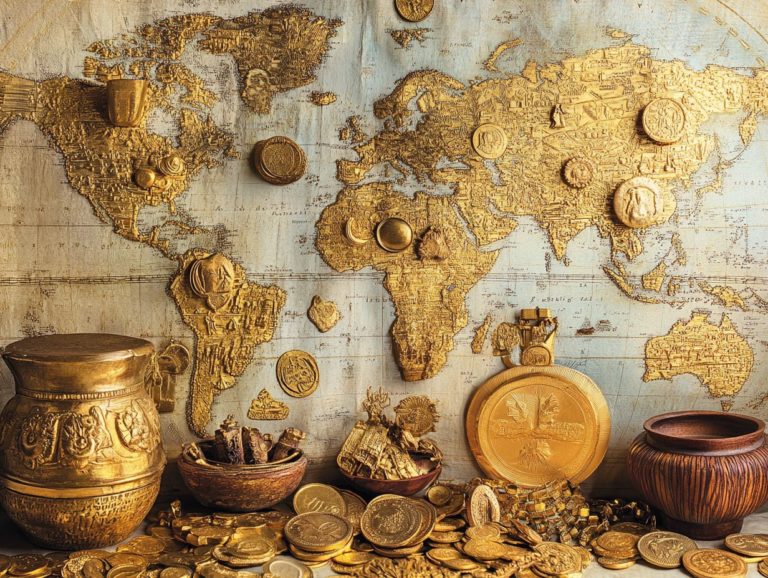5 Tips for Diversifying Your Precious Metal Portfolio
Investing in precious metals can be a rewarding strategy, but it demands careful planning and a solid understanding of the market.
In this article, you ll unlock five essential tips for diversifying your precious metal portfolio, empowering you to navigate the market with confidence. From grasping the various types of metals to identifying current trends, everything you need to make informed decisions will be covered.
Are you ready to supercharge your investments? Let s jump right in!
Contents
- 1. Understand the Different Types of Precious Metals
- 2. Consider the Current Market Trends
- 3. Diversify Across Different Forms of Precious Metals
- Key Takeaways:
- 4. Research and Choose Reputable Dealers
- 5. Regularly Monitor and Rebalance Your Portfolio
- Why Is Diversification Important in Precious Metal Investing?
- Frequently Asked Questions
- What are the benefits of diversifying my precious metal portfolio?
- What are the 5 tips for diversifying my precious metal portfolio?
- How can I diversify my precious metal portfolio without buying physical metals?
- Is it important to stay up-to-date with market trends when diversifying my precious metal portfolio?
- How can I ensure liquidity when diversifying my precious metal portfolio?
- Should I seek professional advice when diversifying my precious metal portfolio?
1. Understand the Different Types of Precious Metals
Understanding the various types of precious metals is crucial for investors aiming to enhance their portfolios. These metals serve as safe-haven assets and offer diversification benefits that can safeguard long-term wealth against unpredictable market volatility and inflation.
Gold, with its rich historical significance and enduring value, has long been a symbol of wealth. Its stability during economic downturns continues to draw investors who appreciate its reliability in uncertain times.
Silver, on the other hand, plays a critical role in numerous industrial applications, particularly in electronics and solar panels. This dual nature makes it appealing for those who value its aesthetic charm and practical uses.
Then there are platinum and palladium, prized for their scarcity and critical function in automotive catalytic converters. Their unique qualities enhance their attractiveness as investment choices.
By incorporating these metals into your investment strategy, you position yourself to potentially benefit from a hedge against economic uncertainties while capitalizing on the distinct characteristics and market demand of each metal.
2. Consider the Current Market Trends
Keeping a close watch on current market trends is essential for investors in precious metals. Factors such as global conflicts and economic decisions made by influential figures like Jerome Powell can significantly impact market volatility and the value of these safe-haven assets.
Fluctuations in inflation rates play a crucial role; when the cost of living rises, it’s common for investors to flock to commodities like gold and silver. Interest rates come into play as well; higher rates generally strengthen the dollar, which can inversely affect the prices of precious metals.
Staying informed about these key indicators helps assess the optimal times to buy or sell, strategically boosting your portfolio’s performance. Understanding global events like trade wars and natural disasters will enhance your investment strategy.
3. Diversify Across Different Forms of Precious Metals
Diversifying across various forms of precious metals can significantly enhance your investment portfolio by harnessing the benefits of diversification. Whether you choose physical bullion, exchange-traded funds (ETFs), or specialized IRAs, this approach can act as a buffer against market downturns.
These investment options enable you to balance exposure to market fluctuations while capitalizing on the intrinsic value that precious metals inherently offer. Physical bullion, such as coins and bars, provides the reassuring appeal of tangible assets.
Exchange-traded funds (ETFs) present a more accessible avenue to invest in a diversified basket of metals, eliminating the need for cumbersome storage solutions. Utilizing specialized IRAs allows you to take advantage of tax benefits, making them compelling choices for long-term investors.
Incorporating these liquid assets into your strategies can lead to a robust portfolio that thrives through economic uncertainty.
Key Takeaways:
Understand the different types of precious metals to make informed investment decisions.
Consider current market trends to determine the best time and types of precious metals to invest in.
Diversify across different forms of precious metals, such as coins, bars, and ETFs, to minimize risk and maximize potential returns.
4. Research and Choose Reputable Dealers
Researching and selecting reputable dealers is essential when investing in precious metals. Doing so ensures you acquire quality assets while steering clear of scams.
Notable names like the United States Gold Bureau, Auctus Metal Portfolios, and CMI Gold & Silver shine brightly in the industry. As you search for a dealer, consider their reputation in the market.
Established dealers usually boast a solid track record of reliability. Transparency is another vital component; a trustworthy dealer will provide clear information about pricing, fees, and the purchasing process for precious metals.
Prioritizing excellent customer service is equally important. Knowledgeable representatives can help guide you through your options.
Verifying certifications such as licenses and memberships in professional organizations and examining consumer reviews are critical steps in ensuring your transactions are legitimate. Doing extra research helps prevent potential pitfalls and fosters a secure investing experience.
5. Regularly Monitor and Rebalance Your Portfolio
Regularly monitoring and rebalancing your investment portfolio is essential for aligning with your financial goals. This practice helps you adapt to the ever-changing market cycles.
By keeping a close eye on your performance metrics, you can spot trends indicating whether certain assets are over or underperforming. This proactive approach maximizes your returns and mitigates risks associated with unforeseen market fluctuations.
To effectively rebalance, consider setting a schedule quarterly or semi-annually to review your asset allocation. Additionally, using tools like diversification strategies and simple risk management techniques can support your efforts.
Remember to factor in your personal objectives, such as retirement timelines or liquidity needs, as they play a crucial role in determining the appropriate adjustments for your portfolio.
Why Is Diversification Important in Precious Metal Investing?
Diversification is essential in precious metal investing, serving as a key strategy to mitigate risks and preserve long-term wealth. This balanced approach involves spreading investments across different types of metals like gold, silver, platinum, and palladium.
Gold is often viewed as a safeguard against inflation, while silver may offer greater growth potential during economic recoveries. The interconnected nature of these asset classes means that when one sector faces challenges, others can flourish, stabilizing your portfolio.
Adopting a well-rounded investment strategy that includes diverse precious metals enhances potential returns. Additionally, learning how to diversify your cryptocurrency portfolio builds resilience against unforeseen economic shifts, enabling you to navigate market complexities more effectively.
What Are the Benefits of Investing in Precious Metals?
Investing in precious metals offers many benefits. These include serving as an effective hedge against inflation, preserving your wealth, and providing liquid assets that can be quickly converted into cash during times of need or market downturns.
Metals like gold and silver are known for retaining value, even when inflation diminishes purchasing power. For instance, in times of economic uncertainty, the price of gold often trends upward, allowing you to mitigate potential losses elsewhere in your portfolio.
Incorporating precious metals into your financial planning is crucial. By allocating a portion of your funds into these tangible assets, you can shield yourself from market volatility and cultivate a more balanced approach to wealth management.
Have you considered how precious metals fit into your overall investment strategy? Start diversifying your investments today to protect your wealth for tomorrow!
What Are the Risks of Investing in Precious Metals?
Investing in precious metals can be a savvy move. However, it s essential to acknowledge the risks that come along for the ride.
Market volatility is a key risk. Also, consider potential capital gains tax implications.
These risks can create a landscape of financial uncertainty, especially when prices swing dramatically due to market fluctuations, geopolitical events, or changes in demand.
Regulatory shifts, such as changes in tax laws or import/export restrictions, can significantly influence the profitability of your investments.
To handle these challenges well, adopt a well-crafted strategy that emphasizes diversification. By spreading your investments across various types of precious metals and even branching out into other asset classes, you can better shield yourself against potential downturns. For more insights, check out this guide on investing in precious metals. This approach helps cultivate a more stable financial portfolio.
How Can One Determine the Right Mix of Precious Metals in Their Portfolio?
Determining the right mix of precious metals in your investment portfolio requires a clear understanding of your financial goals and risk tolerance. This knowledge is key to achieving optimal diversification and balance in your assets.
Several factors, such as your investment horizon, risk appetite, and current market conditions, significantly influence this decision.
If you re a long-term investor, you might prioritize stability and lean toward gold, renowned for retaining value over time. Conversely, if you possess a higher risk tolerance, silver or platinum might capture your interest due to their growth potential.
To effectively assess and adjust your mix, engage in periodic portfolio reviews and conduct market trend analyses. It’s also wise to consider consulting with financial advisors. Staying informed about global economic shifts will help you make informed adjustments, ensuring your portfolio remains in sync with your evolving investment objectives.
What Are the Different Ways to Invest in Precious Metals?
There are several ways for you to invest in precious metals. You can choose to purchase physical bullion, invest in ETFs, or utilize an IRA. Each option comes with its own unique advantages and considerations.
These investment avenues offer varying degrees of liquidity, risk, and accessibility. It s crucial for you to thoughtfully evaluate your financial goals.
While owning physical bullion can provide a comforting tangible asset, it requires secure storage and potentially higher transaction costs. Conversely, investing in ETFs offers easier buying and selling in the market, adding convenience, but you ll need to account for management fees.
If you opt for a precious metals IRA, you’ll benefit from tax-advantaged savings along with the potential for growth. However, be mindful of the specific regulations you must follow.
Understanding how these various methods can complement your overall investment strategy is essential. They can enhance your portfolio diversification and provide protection against market volatility.
What Are the Tax Implications of Investing in Precious Metals?
Knowing the tax implications of your precious metal investments is vital for your success! Capital gains tax can significantly impact your overall returns, requiring strategic planning.
Navigating the specific tax regulations associated with such investments is essential. Capital gains tax rates can vary based on how long you hold your assets. If you keep your metals for over a year, they might be taxed at a lower rate than if you sell them sooner.
Accurate reporting is imperative. You must ensure that your sales are reported correctly to meet IRS requirements. To effectively manage these tax implications, weave tax considerations into your investment strategies.
Consulting with a tax professional who specializes in this area could prove invaluable. Such foresight can enhance your compliance and improve the efficiency of your portfolio.
Frequently Asked Questions
What are the benefits of diversifying my precious metal portfolio?
Diversifying your precious metal portfolio can help reduce risk and increase potential for long-term growth. By spreading your investments across different types of precious metals, you can minimize the impact of market fluctuations on your overall portfolio, which is why understanding the role of precious metals in diversification is crucial.
What are the 5 tips for diversifying my precious metal portfolio?
Diversifying your precious metal portfolio involves five key tips. Consider exploring unique ways to invest in precious metals and invest in different metals like gold, silver, platinum, and palladium.
Consider both physical metals and financial products like stocks and exchange-traded funds (ETFs). Be mindful of liquidity, stay informed about market trends, and seek professional advice.
How can I diversify my precious metal portfolio without buying physical metals?
You can diversify your precious metal portfolio by investing in stocks or ETFs that track metal performance. This approach lets you gain exposure to various metals without owning the physical forms.
Is it important to stay up-to-date with market trends when diversifying my precious metal portfolio?
Yes, staying informed about market trends is crucial. By monitoring market movements, you can make informed decisions on which metals to invest in and when to buy or sell.
How can I ensure liquidity when diversifying my precious metal portfolio?
To ensure liquidity, invest in highly liquid assets like gold or silver coins and bars. ETFs or stocks that track precious metals are also good options since they tend to be more liquid than physical metals.
Should I seek professional advice when diversifying my precious metal portfolio?
Always consider seeking professional advice. An expert can provide valuable insights and help you create a well-balanced portfolio that aligns with your financial goals.






